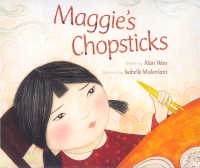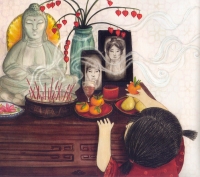| ________________
CM . . . . Volume XIX Number 9 . . . . November 2, 2012
excerpt:
Maggie has just received a pair of her very own chopsticks, but right away, her grandmother, mother, brother, and sister tell her how she should be using them. Everybody has something to say, and they all think that Maggie's way of using her chopsticks is wrong. But with everyone telling her something different, Maggie isn't sure she'll ever get it right, or that she'll ever get to eat!
This is a good story about a child who is faced with something new and isn't sure what to do about it. Although Maggie's personal situation may not be the most relatable to all children (particularly for younger audiences who may not understand what chopsticks are), the message of practicing something new, taking advice from others, and ultimately being yourself is universal. Maggie's struggles with trying to imitate her family members, and the satisfaction she receives once she finally masters her task, are feelings to which that many children will be able to relate. Alan Woo's prose is very poetic, and while the text of this story is fairly short, the words are full of imagery and movement. One such example occurs when Maggie's sister uses her chopsticks by "Crossing her chopsticks back and forth, / Back and forth, / Like legs, / Dancing". The illustrations by Isabelle Malenfant mimic this style well by having the images showcase the movement of the text. Often, the pictures depict Maggie's family using the chopsticks to throw food in the air or carry it to their mouths, and sometimes even the family members, themselves, are posed mid-movement. Combined, the story's narrative and illustrations blend to create an artistic piece of work that nicely balances the simplicity of the storyline. Maggie's Chopsticks tells the story of a girl trying to learn something new. The poetic language of this tale, coupled with the rich illustrations, gives Maggie's story a maturity that older readers can appreciate while the short text and simple, universal message make it a great read for a broader audience. Highly Recommended. Meredith Cleversey is a librarian who lives in Cambridge, ON. She loves to read, write, and live in a world of pure imagination.
To comment
on this title or this review, send mail to cm@umanitoba.ca.
Copyright © the Manitoba Library Association. Reproduction for personal
use is permitted only if this copyright notice is maintained. Any
other reproduction is prohibited without permission.
NEXT REVIEW |
TABLE OF CONTENTS FOR THIS ISSUE
- November 2, 2012.
AUTHORS |
TITLES |
MEDIA REVIEWS |
PROFILES |
BACK ISSUES |
SEARCH |
CMARCHIVE |
HOME |

 Maggie's Chopsticks, written by Alan Woo and illustrated by Isabelle Malenfant, is the story of a girl trying something new. When Maggie gets her chopsticks, almost everyone in her family offers advice on how to use them. But everyone is different, and Maggie can't figure out how to copy what the others do. Only when her father explains to her that her own way of using the chopsticks is unique and okay does Maggie realize that she can accomplish her task, simply by doing it her own way.
Maggie's Chopsticks, written by Alan Woo and illustrated by Isabelle Malenfant, is the story of a girl trying something new. When Maggie gets her chopsticks, almost everyone in her family offers advice on how to use them. But everyone is different, and Maggie can't figure out how to copy what the others do. Only when her father explains to her that her own way of using the chopsticks is unique and okay does Maggie realize that she can accomplish her task, simply by doing it her own way.